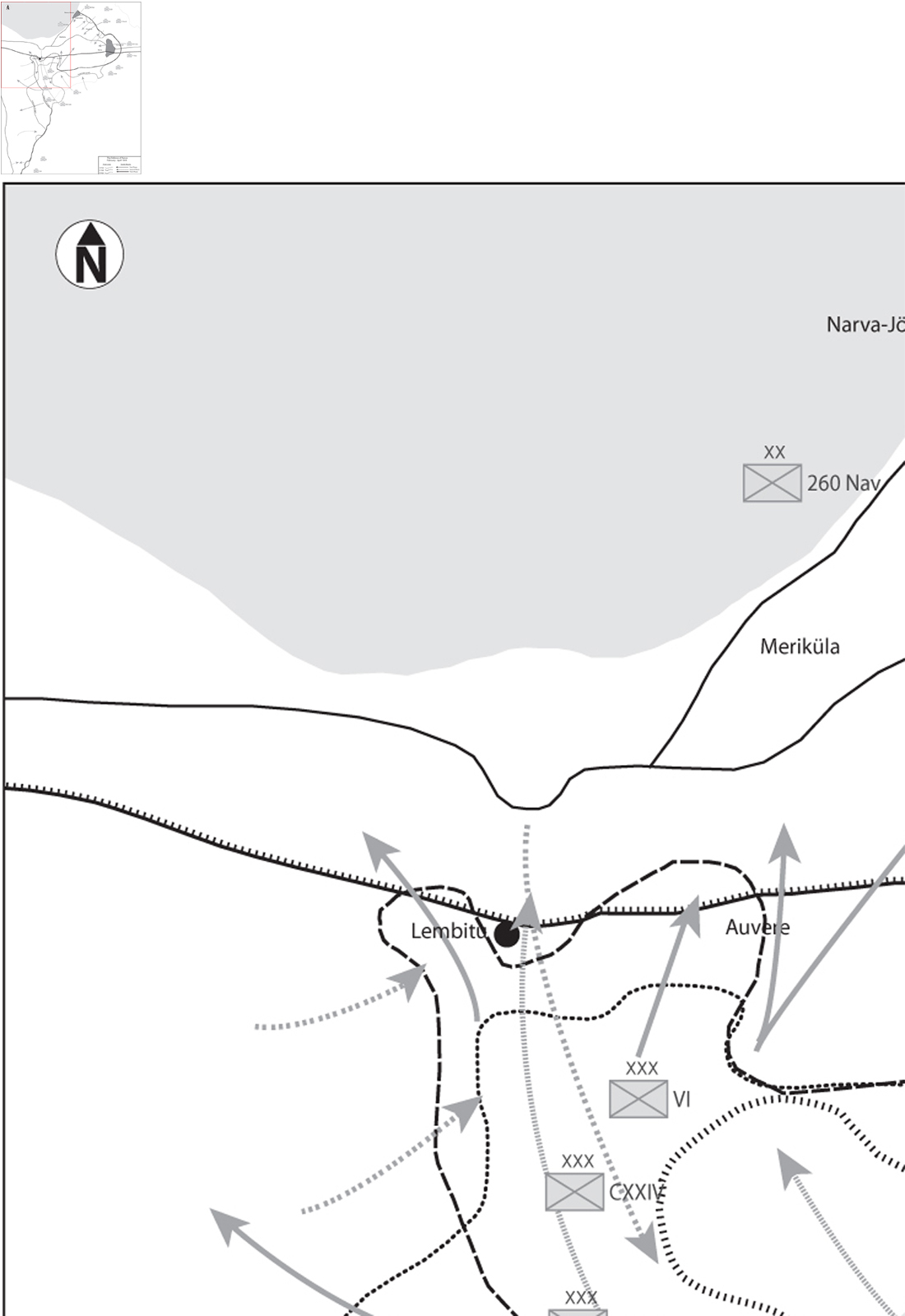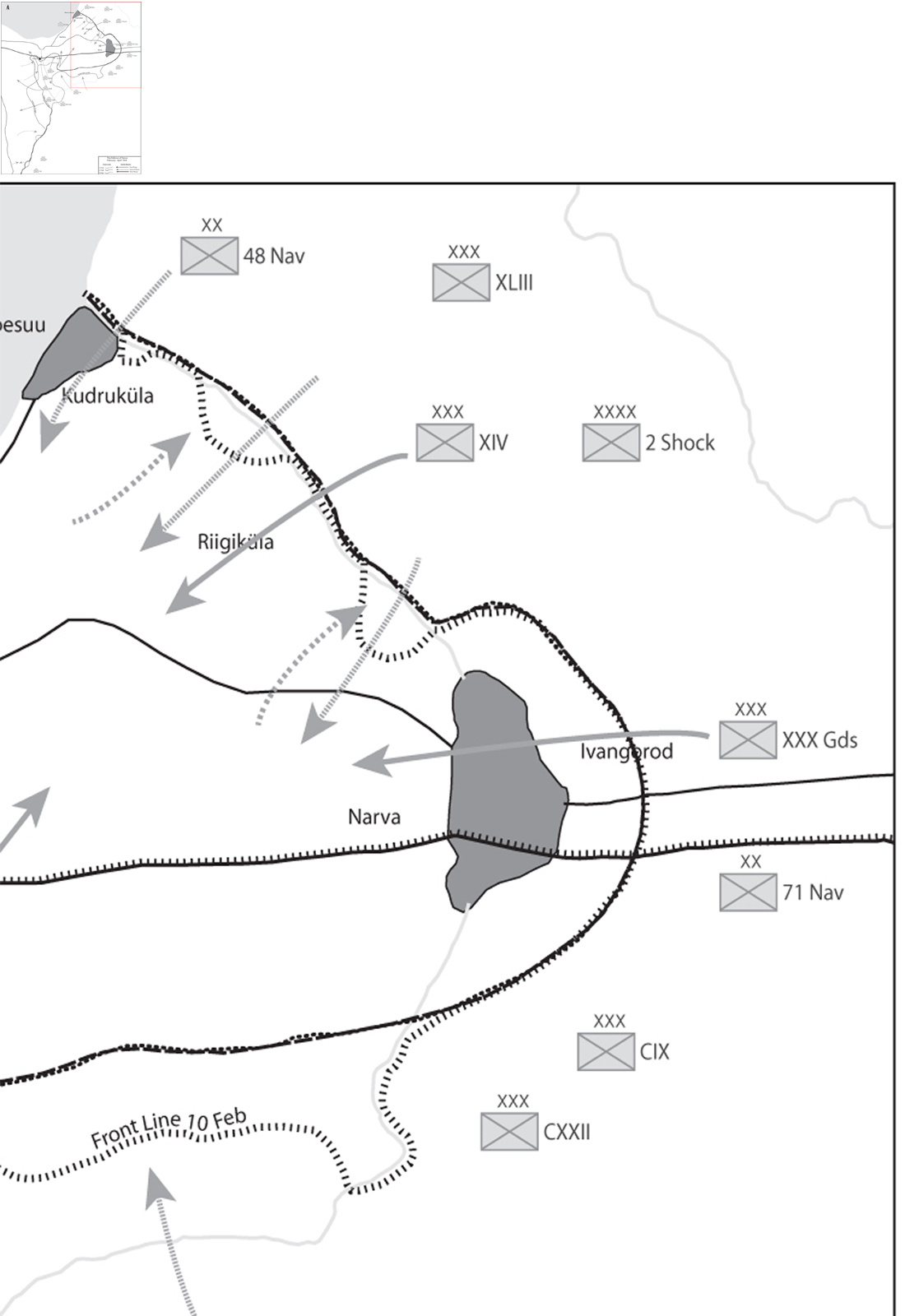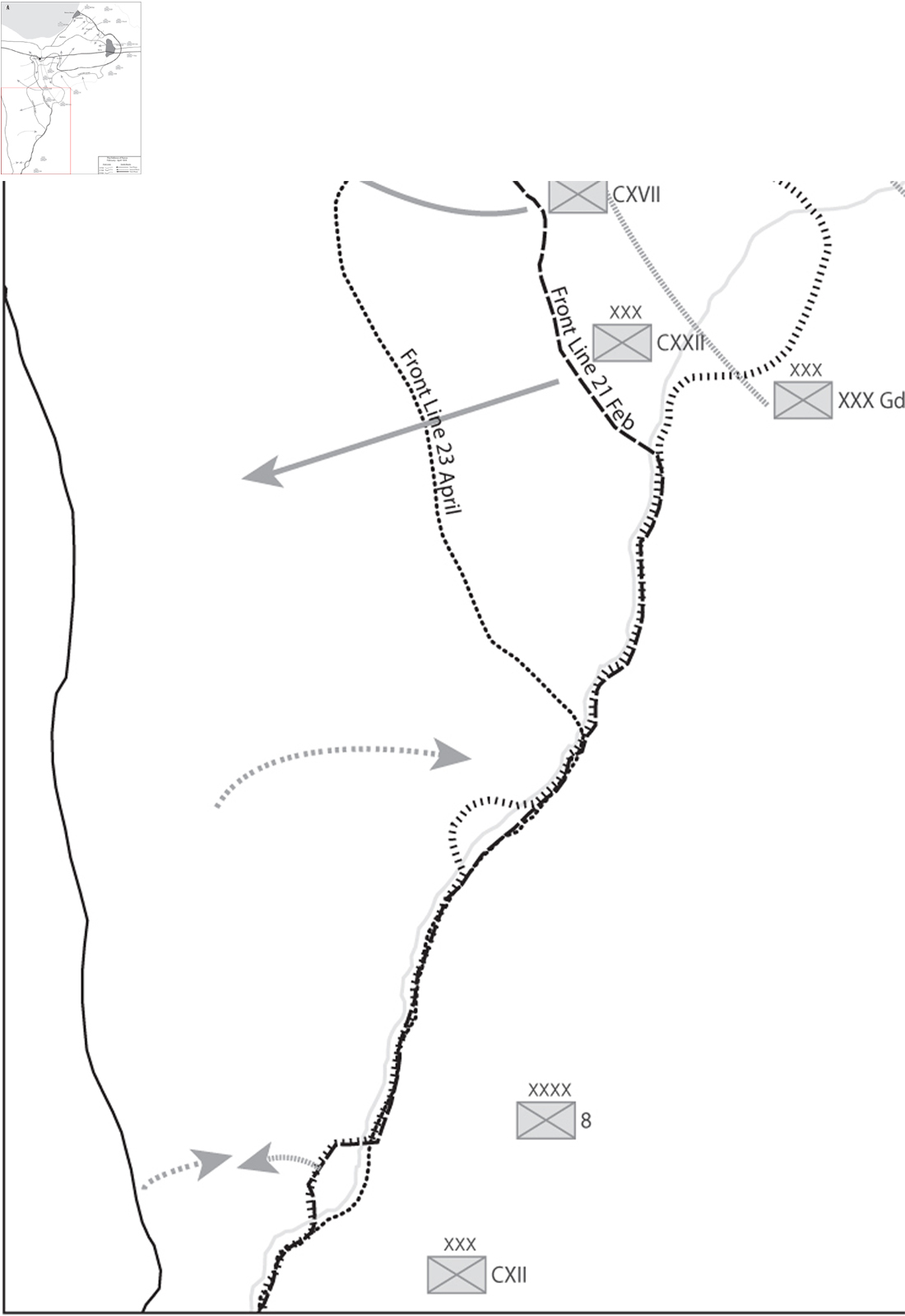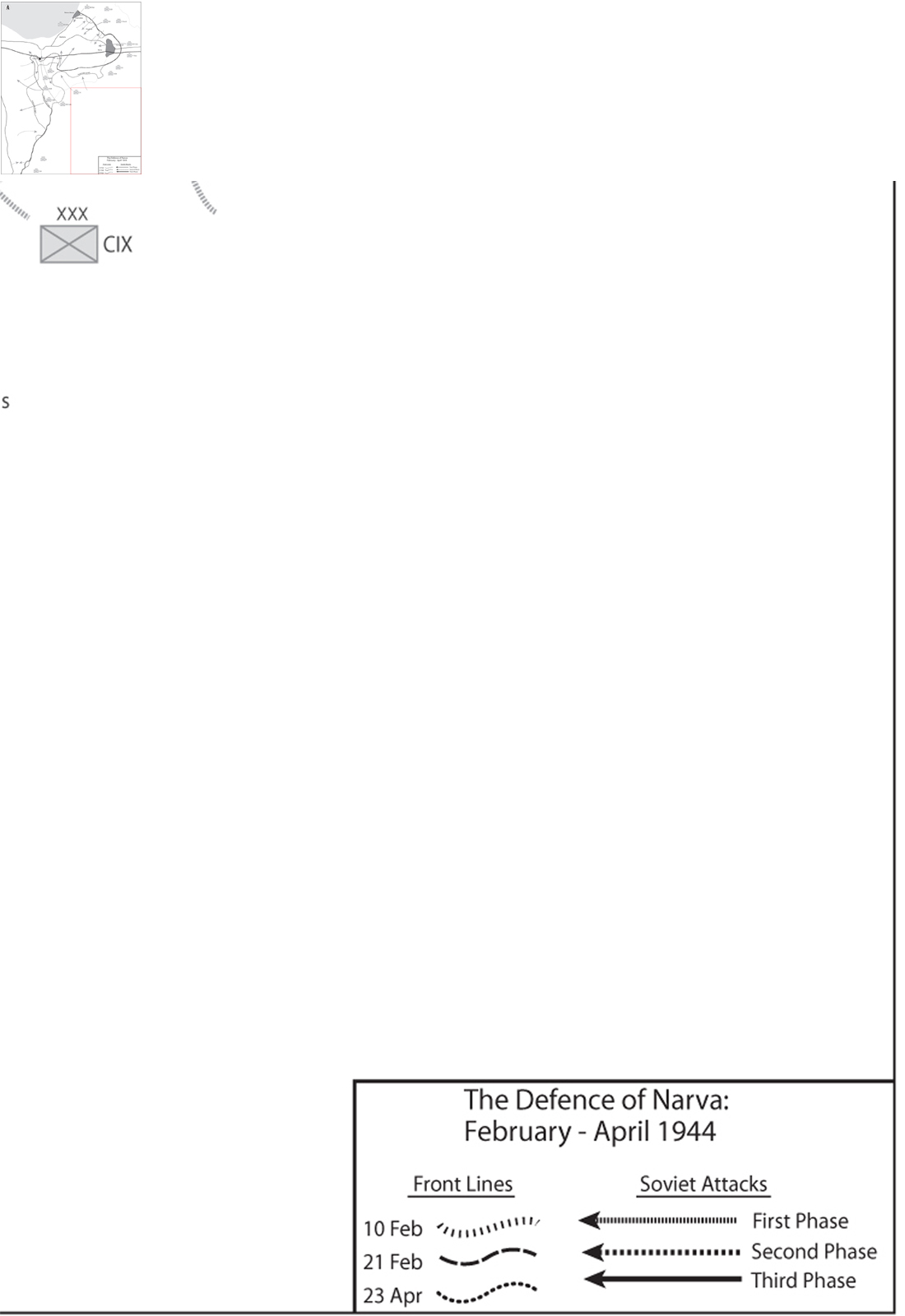Between Giants (32 page)
Authors: Prit Buttar
Tags: #Between Giants: The Battle for the Baltics in World War II

Despite these reinforcements, pressure continued in the north. 10th Luftwaffe Field Division’s commander, Generalleutnant Hermann von Wedel, was badly wounded on 29 January. He was evacuated to a military hospital in Estonia, where he died a week later. His division, now lacking any cohesion, was disbanded, and its survivors added to the ranks of 170th Infantry Division. By the end of the month, 18th Army was in a perilous state. Its infantry strength, already weak at the beginning of the year, had shrunk by over two thirds, and Hitler’s insistence on it continuing to hold its ground, with deep Soviet salients driven into its lines, resulted inevitably in gaps in the front line, in addition to the gap to 16th Army in the south. On 30 January, Küchler managed to secure permission to retreat to the River Luga, but only if he was then able to restore continuity along the front. Soviet forces were already over the Luga, between Luga and Kingisepp, and Küchler’s staff protested that the orders were unworkable. The result was the sacking of Küchler, and his replacement by Generalfeldmarschall Walter Model.
Highly decorated in the First World War, Model had served in the Reichswehr between the wars, when he was strongly influenced by the defensive theories of Generalleutnant Fritz von Lossberg. He was a staff officer in the early campaigns of 1939 and 1940, accompanying 16th Army across Luxembourg and northern France, and commanded 3rd Panzer Division at the onset of
Barbarossa
. He led XLI Panzer Corps during the battle of Moscow, and thereafter showed great defensive skill in command of 9th Army during 1942 and 1943. He was now dispatched to restore the situation in the north.
Model became a field marshal at the age of 53 (he was promoted two months after taking command of Army Group North), the youngest man to hold this rank in the Wehrmacht. Heinz Guderian once described him thus: ‘A bold inexhaustible soldier … the best possible man to perform the fantastically difficult task of reconstructing a line in the centre of the Eastern Front.’
20
He was by all accounts a man who was outspoken to the point of tactlessness, and many of the army’s conservative officers regarded him as suspiciously pro-Nazi. His hard-driving attitude earned him the respect of his men, but in most of his posts, his staff officers found it hard to cope with him – when he took over XLI Panzer Corps, the entire staff requested transfers.
21
His outspoken attitude even extended to Hitler; when the Führer challenged his deployment of part of 9th Army in 1942, he stared down the German leader with the words, ‘Who commands the 9th Army, my Führer, you or I?’
22
The prickly, energetic Model rapidly asserted his personality on the staff at Army Group North. It was clear to him that regardless of Hitler’s orders, it would be suicidal for 18th Army to attempt to hold its current positions. Aware of Hitler’s aversion to withdrawals, he articulated the concept of a ‘shield and sword’ defence, in which the army group would allow a withdrawal from the north into a salient around Luga – the shield – and would then use the forces freed up to mount a sword-like counter-thrust further west against Soviet forces approaching the Estonian border. But even these measures would require time to be executed. Fediuninsky’s 2nd Shock Army, which had broken through the German defences around the Oranienbaum bridgehead, was now ordered to force the line of the Luga, and to reach and cross the River Narva. 42nd Army would advance on Fediuninsky’s southern flank, driving to Lake Peipus, while 67th Army and the entire Volkhov Front attempted to capture Luga itself.
The first phase of the Soviet reconquest of the Baltic States was therefore a direct continuation of the rolling offensive that had driven the Germans back from the gates of Leningrad. 43rd and 122nd Rifle Corps from 2nd Shock Army launched determined attacks on Kingisepp throughout 30 and 31 January, inflicting heavy losses on
SS-Panzergrenadier-Regiment 23 Norge
and
SS-Panzergrenadier- Regiment 24 Danmark
, composed mainly of Norwegian and Danish volunteers respectively. With Soviet forces bypassing the town and crossing the frozen river to north and south, the SS abandoned Kingisepp, blowing the bridges as they left. Elements of III SS Panzer Corps and LIV Corps fought a determined rearguard action to the frozen River Narva, about ten miles to the east, and used explosives to disrupt the ice, in an attempt to prevent the Red Army from achieving early crossings. Nevertheless, the day after the fall of Kingisepp, the Soviet 4th Rifle Regiment, part of 43rd Rifle Corps, managed to establish a small bridgehead north of the city of Narva, while 122nd Rifle Corps crossed the river about six miles further south in the frozen Krivasoo swamps.
In Estonia, the approach of the front line led to a significant change of heart in the leadership installed by the German occupiers. Until now, the Directorate had opposed attempts to mobilise the population for war, but with the Red Army coming ever closer, the acting prime minister, Jüri Uluots, announced a different policy. In a radio broadcast on 7 February, he supported mobilisation, hinting that armed Estonian forces might do more than merely fight the Red Army, and – aware that the Germans would monitor his words – added that their creation could have ‘a significance much wider than what I could and would be able to disclose here’.
23
With the end of the war coming closer, Uluots – like other Baltic politicians – hoped that there would be an opportunity, as there had been in 1918, for Estonia to make a bid for independence. Meanwhile, the civilian population of Narva was evacuated, and the town prepared for a major battle.
Model, meanwhile, attempted to reshuffle his meagre resources. Lindemann was ordered to adopt a defensive line closer to Luga, reducing the length of front line substantially. 12th Panzer Division would attack to restore contact with 16th Army to the south, and thereafter – in conjunction with 58th Infantry Division – would drive down the Luga valley to link up with the forces facing Fediuninsky on the Narva. Such an operation was probably beyond the strength of the forces deployed, given the unfavourable ratios of strength between the opposing sides, but the most pressing concern was to shore up the defences on the Narva. If these were to give way, the consequences could be catastrophic for 18th Army, Army Group North, and indeed the entire German position on the Eastern Front. The capture of Narva would open the way for the Red Army to advance along the Estonian coast to Tallinn, allowing the Red Banner Fleet to venture out further into the Baltic. The oil shale plant on the Estonian coast, one of the few remaining oil resources that the Reich still controlled, would be lost, and a rapid advance by Soviet troops across Estonia, to the west of Lake Peipus, would threaten to roll up the entire German front line. Politically, the consequences could also be serious. Hitler was aware that the Finns were attempting to negotiate a ceasefire with the Soviet Union, and keeping control of the Estonian coast was vital if this was to be prevented.
Narva now became the focus of the fighting. The city first developed as an established settlement in the 13th century when the Danes built the imposing Hermannsburg fortress on the west bank of the Narva. Downstream of the city, the east bank of the Narva climbs rapidly, compared with the relatively flat land to the west; consequently, Soviet forces approaching from the east had a good view of the German positions, and were able to observe troop movements and call down artillery fire whenever targets presented themselves.
On 2 February, Model visited the Narva positions. Otto Sponheimer, commander of LIV Corps, was given command of all the forces along the river, directly subordinate to Army Group North, first as
Gruppe Sponheimer
, then as Army Detachment Narva after Sponheimer was replaced by General Johannes Friessner on 23 February. A steady stream of reinforcements arrived to shore up the line, so that by the last week of February, Army Detachment Narva had an impressive array of forces at its disposal. One of the new units to be sent to the area was the Panzergrenadier Division
Feldherrnhalle
, dispatched from Army Group Centre. Originally built around the remnants of the 60th Motorised Infantry Division, which was destroyed in Stalingrad, this division contained large numbers of former members of the
Sturmabteilungen
or SA, the pre-war paramilitary wing of the National Socialist Party; it was therefore named in honour of Hitler’s failed attempt to seize power in 1923. It now provided much-needed armoured support for the hard-pressed forces on the Narva.




The Red Army, too, was reinforcing the area. 43rd Rifle Corps sent more troops across the Narva, and managed to push forward a little over a mile, but failed to make further progress in the face of resistance from 227th Infantry Division and the
SS Panzergrenadier Brigade Nederland
. A German counter-attack followed, driving the exhausted Soviet infantry back across the river at Kudruküla in early February. The following day, the Germans had a welcome surprise: the 30 survivors of a company from
SS-Norge
, cut off during the retreat, managed to reach German lines after a 14-day march. Sadly for them, their Norwegian
Untersturmführer
was killed by German fire when they crossed the frozen Narva.
24
In an attempt to outflank the German defences, the Red Banner Fleet attempted to land two naval infantry brigades on the coast late on 13 February in a flotilla of 26 vessels of varying sizes.
25
The intention was to achieve a landing near the town of Meriküla, but Estonian military planners had considered such a landing as a possibility at least since 1939. Consequently, the artillery positions constructed as part of the German Panther Line allowed for such a landing, and the first wave of Soviet troops found themselves faced by tough defences. Nevertheless, they succeeded in reaching Meriküla, where they surrounded the headquarters of
Kampfgruppe Berlin
, a mixed force responsible for defending this section of coast. As it began to grow light the following day, a German counter-attack restored contact with the Germans trapped in Meriküla. Backed by the German coastal artillery and a small group of Tiger tanks from
Schwere Panzer Abteilung 502
, a mixed force of Estonian and German troops crushed the landing attempt, despite a Stuka raid that erroneously bombed the Tiger tanks. The Soviet forces lost about 750 dead or captured.
26
